CORTONA, AREZZO, PISTOIA
Breakfast at La Cima on the patio was the best we had in Italy.
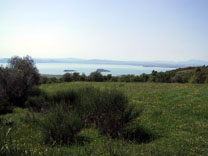
There were fresh croissants (cornetti),and five different kinds
of homemade preserves: fig, strawberry, lemon marmalade, green tomato marmalade.
There were also cornflakes made in Pisa with the name of "Fred Cooper."
Also a selection of different kinds of hams and cheeses (lots of German
tourists in Northern Italy--loud, pushy, clannish--whoops, that's what
they say about the Jews, too."
We drove to Cortona,
to catch the Etruscan artefacts in this hilltop town made famous by Frances
Mays in her book, Under
the Tuscan Sun. But the museum was closed, so we just walked around
a bit. We took a small road to Arezzo,
heading for the Church of San Francesco, which houses the restored frescoes
of The Legend of the
True Cross by Piero Della Francesca.
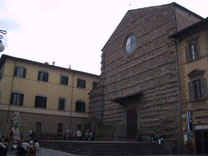
Located in the choir chapel of the church, this 15th Century work is
considered by true cognoscenti, one of the most important Renaissance pieces
for its incorporation of contemporary touches, e.g., the clothing of the
time and the faces of the donors of the chapel. Thank God, Carol was there
to explain it all to me, because to me, it looked a little one-dimensional
and worn out.
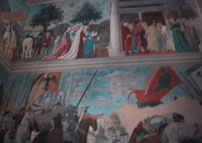 ..
..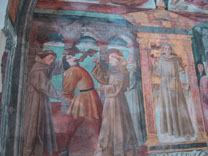
Then we went on what Carol calls "The Drive from Hell," the superstradafrom
Arezzo to Pistoia. It's just like any American 4-lane interstate, but there
are no speed limits. I took the Renault up to 180 kph. This is not fast
enough, however, to keep others from pulling up to within 5 feet behind
you, which is there way of signaling that they'd like to pass. Every time
I would yell that this was a "fabulous ride," Carol would remind me that
it was a road, not a ride, and that we were not in an amusement park.
We arrived in Pistoia,
and checked into the Hotel
Leon Bianco.
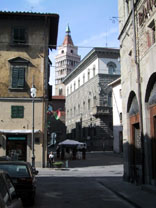 ..
..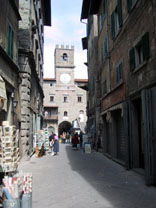
Pistoia is about 20 minutes from the Florence airport. It is a small
city, manageable in size, with a surprising number of fashionable boutiques,
a far cry from its reputation in medieval times, when it was a hotbed of
violence and intrigue. The pistol was invented in and named for this town.
We walked around, looked at their 12th Century Duomo of green and white
stripes, with a lunette over the door by Andrea Della Robbia. Nearby was
a plaza filled with greengrocers selling fruit and vegetables, while the
stores on the periphery were all butcher shops, filled with meat and organs--all
squeaky clean.
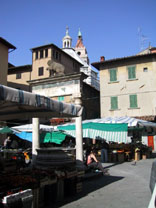 ..
..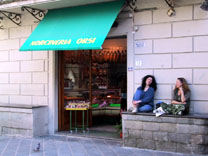
We bought some cherries and peaches from the most affable of the fruitsellers,
a short ebullient man named Sauro, who gets a mention in Mario
Batali's cookbooks for having superb vegetables and fruit. When we
told him that our kids would be taking us to Babbo
in New York next month, he gave us his calling card, inscribing on it,
"A Mario--il Grande, del su amico, Sauro." We hope that this will get us
a good table.
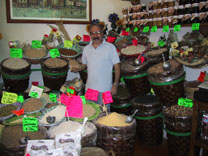
For dinner, we went to Corradossi,
where we had primi and secondi platti. I had pasta with clam sauce with
fish roe--good but not as good as the spaghetti with white clam sauce at
Guido's in Providence, and Carol had the best gnocchi she ever ate, with
cheese and chives. Then one last melone con prosciutto for me and
a garden salad for Carol. We drank a Vernaccio from San Gimignano, with
fragole,wild
strawberries with lemon. The best part of the meal, however, was watching
two guys at an adjoining table, who had about 15 different courses. The
younger of them wolfed down food as though he had just been released from
prison...or was about to go in.
We drove to the airport and had an easy flight home, except for a horrible
smell from the bathroom behind our seats for a good bit of the flight.
The cabin attendant would not let us sit in Business Class...after we saved
Belgium from the Hun. Sabena is getting a Letter from Farklempt.
After every trip, we say that this was the best ever. This one really
was.
Back to previous page
Back to start of trip
Home


 ..
..
 ..
..
 ..
..
